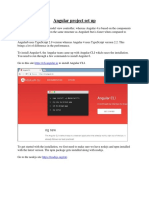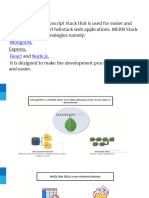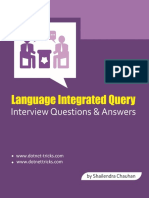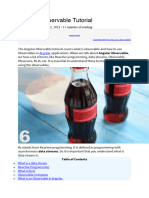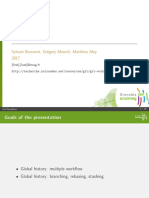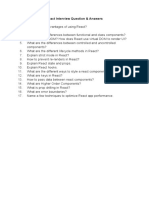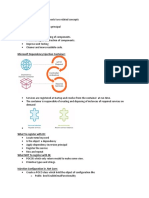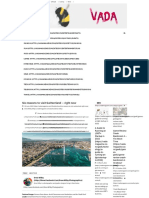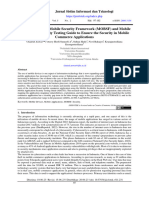MVC Interview Questions With Answers - CodeProject
MVC Interview Questions With Answers - CodeProject
Uploaded by
mahesh591Copyright:
Available Formats
MVC Interview Questions With Answers - CodeProject
MVC Interview Questions With Answers - CodeProject
Uploaded by
mahesh591Original Description:
Copyright
Available Formats
Share this document
Did you find this document useful?
Is this content inappropriate?
Copyright:
Available Formats
MVC Interview Questions With Answers - CodeProject
MVC Interview Questions With Answers - CodeProject
Uploaded by
mahesh591Copyright:
Available Formats
10/14/2014 MVC interview questions with answers - CodeProject
http://www.codeproject.com/Articles/556995/MVC-interview-questions-with-answers 1/36
Rate this:
Shivprasad koirala, Marla Sukesh, 14 Sep 2014 CPOL
MVC interview questions with answers
The whole purpose of this article is to quickly brush up your MVC knowledge from an MVC interview
perspective.
Download MVC.zip - 1.1 MB
Table of content
Disclaimer
What is MVC (Model view controller)?
Explain MVC application life cycle?
Is MVC suitable for both Windows and web applications?
What are the benefits of using MVC?
Is MVC different from a three layered architecture?
What is the latest version of MVC?
What is the difference between each version of MVC?
What are HTML helpers in MVC?
What is the difference between HTML.TextBox vs HTML.TextBoxFor?
What is routing in MVC?
Where is the route mapping code written?
Can we map multiple URLs to the same action?
How can we navigate from one view to other view using a hyperlink?
How can we restrict MVC actions to be invoked only by GET or POST?
How can we maintain sessions in MVC?
What is the difference between tempdata, viewdata, and viewbag?
What is difference between TempData and ViewData ?
Does TempData preserve data in the next request also?
What is the use of Keep and Peek in TempData?
What are partial views in MVC?
How do you create a partial view and consume it?
How can we do validations in MVC?
Can we display all errors in one go?
How can we enable data annotation validation on the client side?
What is Razor in MVC?
Why Razor when we already have ASPX?
So which is a better fit, Razor or ASPX?
How can you do authentication and authorization in MVC?
How to implement Windows authentication for MVC?
How do you implement Forms authentication in MVC?
How to implement AJAX in MVC
4.87 (310 votes)
10/14/2014 MVC interview questions with answers - CodeProject
http://www.codeproject.com/Articles/556995/MVC-interview-questions-with-answers 2/36
What kind of events can be tracked in AJAX?
What is the difference between ActionResult and ViewResult?
What are the different types of results in MVC?
What are ActionFilters in MVC?
Can we create our own custom view engine using MVC?
How to send result back in JSON format in MVC
What is WebAPI?
But WCF SOAP also does the same thing, so how does WebAPI differ?
With WCF you can implement REST, so why WebAPI?
How can we detect that a MVC controller is called by POST or GET?
What is Bundling and Minification in MVC?
How does bundling increase performance?
How do we implement bundling in MVC?
How can you test bundling in debug mode?
Explain minification and how to implement it
How do we implement minification?
Explain Areas in MVC?
Explain the concept of View Model in MVC?
What kind of logic view model class will have?
How can we use two ( multiple) models with a single view?
Explain the need of display mode in MVC?
Explain MVC model binders?
Explain the concept of MVC Scaffolding?
What does scaffolding use internally to connect to database?
Disclaimer
Reading these MVC interview questions does not mean you will go and clear MVC interviews. The purpose of
this article is to quickly brush up your MVC knowledge before you go for MVC interviews. This article does
not teach MVC, its a last minute revision sheet before going for MVC interviews.
If you want to learn MVC from scratch, start by reading Learn MVC ( Model view controller) step by step 7
days or you can also start with my step by step MVC (Model View Controller) video series from YouTube.
If you want to learn MVC 5 in a short time i.e. 2 days a.k.a 16 hours below is a video series for the same.
10/14/2014 MVC interview questions with answers - CodeProject
http://www.codeproject.com/Articles/556995/MVC-interview-questions-with-answers 3/36
Need help to improve this article
I have tried my level best to cover what questions i have faced in MVC interviews. But i feel the below
questions are not enough and in real MVC interview's much more is asked. If you can share your question in
the comment below. I would love to incorporate them in this article so that others are benefited.
If your question is great and i like it i will ship you a free copy of my .NET interview question book only in
India ( sorry i am not so rich for outside countries).
What is MVC (Model View Controller)?
MVC is an architectural pattern which separates the representation and user interaction. Its divided into three
broader sections, Model, View, and Controller. Below is how each one of them handles the task.
The View is responsible for the look and feel.
Model represents the real world object and provides data to the View.
The Controller is responsible for taking the end user request and loading the appropriate Model and
View.
10/14/2014 MVC interview questions with answers - CodeProject
http://www.codeproject.com/Articles/556995/MVC-interview-questions-with-answers 4/36
Figure: MVC (Model view controller)
Explain MVC application life cycle?
There are six broader events which occur in MVC application life cycle below diagrams summarize it.
Image Courtesy: - http://www.dotnetinterviewquestions.in/article_explain-mvc-application-life-cycle_210.html
Any web application has two main execution steps first understanding the request and depending on the
type of the request sending out appropriate response. MVC application life cycle is not different it has two
main phases first creating the request object and second sending our response to the browser.
Creating the request object: -The request object creation has four major steps. Below is the detail
explanation of the same.
Step 1 Fill route: - MVC requests are mapped to route tables which in turn specify which controller and
action to be invoked. So if the request is the first request the first thing is to fill the route table with routes
collection. This filling of route table happens in the global.asax file.
Step 2 Fetch route: - Depending on the URL sent UrlRoutingModule searches the route table to create
RouteData object which has the details of which controller and action to invoke.
Step 3 Request context created: - The RouteData object is used to create the RequestContext object.
Step 4 Controller instance created: - This request object is sent to MvcHandler instance to create the
10/14/2014 MVC interview questions with answers - CodeProject
http://www.codeproject.com/Articles/556995/MVC-interview-questions-with-answers 5/36
controller class instance. Once the controller class object is created it calls the Execute method of the
controller class.
Creating Response object: - This phase has two steps executing the action and finally sending the response
as a result to the view.
Is MVC suitable for both Windows and Web
applications?
The MVC architecture is suited for a web application than Windows. For Window applications, MVP, i.e.,
Model View Presenter is more applicable. If you are using WPF and Silverlight, MVVM is more suitable due
to bindings.
What are the benefits of using MVC?
There are two big benefits of MVC:
Separation of concerns is achieved as we are moving the code-behind to a separate class file. By
moving the binding code to a separate class file we can reuse the code to a great extent.
Automated UI testing is possible because now the behind code (UI interaction code) has moved to a
simple .NET class. This gives us opportunity to write unit tests and automate manual testing.
Is MVC different from a three layered architecture?
MVC is an evolution of a three layered traditional architecture. Many components of the three layered
architecture are part of MVC. So below is how the mapping goes:
Functionality Three layered / tiered architecture Model view controller architecture
Look and Feel User interface View
UI logic User interface Controller
Business logic /validations Middle layer Model
Request is first sent to User interface Controller
Accessing data Data access layer Data Access Layer
10/14/2014 MVC interview questions with answers - CodeProject
http://www.codeproject.com/Articles/556995/MVC-interview-questions-with-answers 6/36
Figure: Three layered architecture
What is the latest version of MVC?
When this note was written, four versions were released of MVC: MVC 1 , MVC 2, MVC 3, and MVC 4. So the
latest is MVC 4.
What is the difference between each version of
MVC?
Below is a detailed table of differences. But during an interview its difficult to talk about all of them due to
time limitation. So I have highlighted the important differences that you can run through before the
interviewer.
MVC 2 MVC 3 MVC 4
Client-side validation
Templated Helpers Areas
Asynchronous Controllers
Html.ValidationSummary Helper
Method
DefaultValueAttribute in Action-
Method
Razor
Readymade project
templates
HTML 5 enabled
templates
Support for Multiple
View Engines,
ASP.NET Web API
Refreshed and
modernized default
project templates.
New mobile project
template.
Many new features
10/14/2014 MVC interview questions with answers - CodeProject
http://www.codeproject.com/Articles/556995/MVC-interview-questions-with-answers 7/36
Parameters binding
Binary data with Model Binders
DataAnnotations Attributes
Model-Validator Providers
New RequireHttpsAttributeAction
Filter
Templated Helpers
Display Model-Level Errors
JavaScript, and
AJAX
Model Validation
Improvements
to support mobile
apps
Enhanced support for
asynchronous
methods
What are HTML helpers in MVC?
HTML helpers help you to render HTML controls in the view. For instance if you want to display a HTML
textbox on the view , below is the HTML helper code.
Collapse | Copy Code
<%= Html.TextBox("LastName") %>
For checkbox below is the HTML helper code. In this way we have HTML helper methods for every HTML
control that exists.
Collapse | Copy Code
<%= Html.CheckBox("Married") %>
What is the difference between HTML.TextBox vs
HTML.TextBoxFor?
Both of them provide the same HTML output, HTML.TextBoxFor is strongly typed while HTML.TextBox
isnt. Below is a simple HTML code which just creates a simple textbox with CustomerCode as name.
Collapse | Copy Code
Html.TextBox("CustomerCode")
Below is Html.TextBoxFor code which creates HTML textbox using the property name CustomerCode from
object m.
Collapse | Copy Code
Html.TextBoxFor(m => m.CustomerCode)
In the same way we have for other HTML controls like for checkbox we have Html.CheckBox and
Html.CheckBoxFor.
What is routing in MVC?
10/14/2014 MVC interview questions with answers - CodeProject
http://www.codeproject.com/Articles/556995/MVC-interview-questions-with-answers 8/36
Routing helps you to define a URL structure and map the URL with the controller.
For instance lets say we want that when a user types http://localhost/View/ViewCustomer/, it goes to the
Customer Controller and invokes the DisplayCustomer action. This is defined by adding an entry in to
the routescollection using the maproute function. Below is the underlined code which shows how the URL
structure and mapping with controller and action is defined.
Collapse | Copy Code
routes.MapRoute(
"View", // Route name
"View/ViewCustomer/{id}", // URL with parameters
new { controller = "Customer", action = "DisplayCustomer",
id = UrlParameter.Optional }); // Parameter defaults
Where is the route mapping code written?
The route mapping code is written in the global.asax file.
Can we map multiple URLs to the same action?
Yes, you can, you just need to make two entries with different key names and specify the same controller and
action.
How can we navigate from one view to another
using a hyperlink?
By using the ActionLink method as shown in the below code. The below code will create a simple URL
which helps to navigate to the Home controller and invoke the GotoHome action.
Collapse | Copy Code
<%= Html.ActionLink("Home","Gotohome") %>
How can we restrict MVC actions to be invoked
only by GET or POST?
We can decorate the MVC action with the HttpGet or HttpPost attribute to restrict the type of HTTP calls.
For instance you can see in the below code snippet the DisplayCustomer action can only be invoked
by HttpGet. If we try to make HTTP POST on DisplayCustomer, it will throw an error.
Collapse | Copy Code
[HttpGet]
public ViewResult DisplayCustomer(int id)
10/14/2014 MVC interview questions with answers - CodeProject
http://www.codeproject.com/Articles/556995/MVC-interview-questions-with-answers 9/36
{
Customer objCustomer = Customers[id];
return View("DisplayCustomer",objCustomer);
}
How can we maintain sessions in MVC?
Sessions can be maintained in MVC by three ways: tempdata, viewdata, and viewbag.
What is the difference between tempdata,
viewdata, and viewbag?
Figure: Difference between tempdata, viewdata, and viewbag
Temp data - Helps to maintain data when you move from one controller to another controller or from
one action to another action. In other words when you redirect, tempdata helps to maintain data
between those redirects. It internally uses session variables.
View data - Helps to maintain data when you move from controller to view.
View Bag - Its a dynamic wrapper around view data. When you use Viewbag type, casting is not
required. It uses the dynamic keyword internally.
10/14/2014 MVC interview questions with answers - CodeProject
http://www.codeproject.com/Articles/556995/MVC-interview-questions-with-answers 10/36
Figure: dynamic keyword
Session variables - By using session variables we can maintain data from any entity to any entity.
Hidden fields and HTML controls - Helps to maintain data from UI to controller only. So you can
send data from HTML controls or hidden fields to the controller using POST or GET HTTP methods.
Below is a summary table which shows the different mechanisms for persistence.
Maintains data between ViewData/ViewBag TempData Hidden fields Session
Controller to Controller No Yes No Yes
Controller to View Yes No No Yes
View to Controller No No Yes Yes
What is difference between TempData and
ViewData ?
TempData maintains data for the complete request while ViewData maintains data only from Controller to
the view.
Does TempData preserve data in the next
request also?
TempData is available through out for the current request and in the subsequent request its available
depending on whether TempData is read or not.
So if TempData is once read it will not be available in the subsequent request.
10/14/2014 MVC interview questions with answers - CodeProject
http://www.codeproject.com/Articles/556995/MVC-interview-questions-with-answers 11/36
What is the use of Keep and Peek in TempData?
Once TempData is read in the current request its not available in the subsequent request. If we want
TempData to be read and also available in the subsequent request then after reading we need to call Keep
method as shown in the code below.
Collapse | Copy Code
@TempData[MyData];
TempData.Keep(MyData);
The more shortcut way of achieving the same is by using Peek. This function helps to read as well advices
MVC to maintain TempData for the subsequent request.
Collapse | Copy Code
string str = TempData.Peek("Td").ToString();
If you want to read more in detail you can read from this detailed blog on MVC Peek and Keep.
What are partial views in MVC?
Partial view is a reusable view (like a user control) which can be embedded inside other view. For example
lets say all your pages of your site have a standard structure with left menu, header, and footer as shown in
the image below.
Figure: Partial views in MVC
For every page you would like to reuse the left menu, header, and footer controls. So you can go and create
partial views for each of these items and then you call that partial view in the main view.
How did you create a partial view and consume it?
When you add a view to your project you need to check the Create partial view check box.
10/14/2014 MVC interview questions with answers - CodeProject
http://www.codeproject.com/Articles/556995/MVC-interview-questions-with-answers 12/36
Figure: Create partial view
Once the partial view is created you can then call the partial view in the main view using
the Html.RenderPartialmethod as shown in the below code snippet:
Collapse | Copy Code
<body>
<div>
<% Html.RenderPartial("MyView"); %>
</div>
</body>
How can we do validations in MVC?
One of the easiest ways of doing validation in MVC is by using data annotations. Data annotations are
nothing but attributes which can be applied on model properties. For example, in the below code snippet we
have a simpleCustomer class with a property customercode.
This CustomerCode property is tagged with a Required data annotation attribute. In other words if this
model is not provided customer code, it will not accept it.
Collapse | Copy Code
public class Customer
{
[Required(ErrorMessage="Customer code is required")]
public string CustomerCode
{
set;
get;
}
10/14/2014 MVC interview questions with answers - CodeProject
http://www.codeproject.com/Articles/556995/MVC-interview-questions-with-answers 13/36
}
In order to display the validation error message we need to use the ValidateMessageFor method which
belongs to the Html helper class.
Collapse | Copy Code
<% using (Html.BeginForm("PostCustomer", "Home", FormMethod.Post))
{ %>
<%=Html.TextBoxFor(m => m.CustomerCode)%>
<%=Html.ValidationMessageFor(m => m.CustomerCode)%>
<input type="submit" value="Submit customer data" />
<%}%>
Later in the controller we can check if the model is proper or not by using
the ModelState.IsValid property and accordingly we can take actions.
Collapse | Copy Code
public ActionResult PostCustomer(Customer obj)
{
if (ModelState.IsValid)
{
obj.Save();
return View("Thanks");
}
else
{
return View("Customer");
}
}
Below is a simple view of how the error message is displayed on the view.
Figure: Validations in MVC
Can we display all errors in one go?
Yes, we can; use the ValidationSummary method from the Html helper class.
Collapse | Copy Code
<%= Html.ValidationSummary() %>
What are the other data annotation attributes for validation in MVC?
If you want to check string length, you can use StringLength.
10/14/2014 MVC interview questions with answers - CodeProject
http://www.codeproject.com/Articles/556995/MVC-interview-questions-with-answers 14/36
Collapse | Copy Code
[StringLength(160)]
public string FirstName { get; set; }
In case you want to use a regular expression, you can use the RegularExpression attribute.
Collapse | Copy Code
[RegularExpression(@"[A-Za-z0-9._%+-]+@[A-Za-z0-9.-]+\.[A-Za-z]{2,4}")]public string Email { get;
set; }
If you want to check whether the numbers are in range, you can use the Range attribute.
Collapse | Copy Code
[Range(10,25)]public int Age { get; set; }
Sometimes you would like to compare the value of one field with another field, we can use
the Compare attribute.
Collapse | Copy Code
public string Password { get; set; }[Compare("Password")]public string ConfirmPass { get; set; }
In case you want to get a particular error message , you can use the Errors collection.
Collapse | Copy Code
var ErrMessage = ModelState["Email"].Errors[0].ErrorMessage;
If you have created the model object yourself you can explicitly call TryUpdateModel in your controller to
check if the object is valid or not.
Collapse | Copy Code
TryUpdateModel(NewCustomer);
In case you want add errors in the controller you can use the AddModelError function.
Collapse | Copy Code
ModelState.AddModelError("FirstName", "This is my server-side error.");
How can we enable data annotation validation on
client side?
Its a two-step process: first reference the necessary jQuery files.
Collapse | Copy Code
<script src="<%= Url.Content("~/Scripts/jquery-1.5.1.js") %>" type="text/javascript"></script>
<script src="<%= Url.Content("~/Scripts/jquery.validate.js") %>" type="text/javascript"></script>
<script src="<%= Url.Content("~/Scripts/jquery.validate.unobtrusive.js") %>" type="text/javascript">
</script>
10/14/2014 MVC interview questions with answers - CodeProject
http://www.codeproject.com/Articles/556995/MVC-interview-questions-with-answers 15/36
The second step is to call the EnableClientValidation method.
Collapse | Copy Code
<% Html.EnableClientValidation(); %>
What is Razor in MVC?
Its a light weight view engine. Till MVC we had only one view type, i.e., ASPX. Razor was introduced in MVC 3.
Why Razor when we already have ASPX?
Razor is clean, lightweight, and syntaxes are easy as compared to ASPX. For example, in ASPX to display
simple time, we need to write:
Collapse | Copy Code
<%=DateTime.Now%>
In Razor, its just one line of code:
Collapse | Copy Code
@DateTime.Now
So which is a better fit, Razor or ASPX?
As per Microsoft, Razor is more preferred because its light weight and has simple syntaxes.
How can you do authentication and authorization
in MVC?
You can use Windows or Forms authentication for MVC.
How to implement Windows authentication for
MVC?
For Windows authentication you need to modify the web.config file and set the authentication mode to
Windows.
Collapse | Copy Code
<authentication mode="Windows"/>
10/14/2014 MVC interview questions with answers - CodeProject
http://www.codeproject.com/Articles/556995/MVC-interview-questions-with-answers 16/36
<authorization>
<deny users="?"/>
</authorization>
Then in the controller or on the action, you can use the Authorize attribute which specifies which users have
access to these controllers and actions. Below is the code snippet for that. Now only the users specified in the
controller and action can access it.
Collapse | Copy Code
[Authorize(Users= @"WIN-3LI600MWLQN\Administrator")]
public class StartController : Controller
{
//
// GET: /Start/
[Authorize(Users = @"WIN-3LI600MWLQN\Administrator")]
public ActionResult Index()
{
return View("MyView");
}
}
How do you implement Forms authentication in
MVC?
Forms authentication is implemented the same way as in ASP.NET. The first step is to set the authentication
mode equal to Forms. The loginUrl points to a controller here rather than a page.
Collapse | Copy Code
<authentication mode="Forms">
<forms loginUrl="~/Home/Login" timeout="2880"/>
</authentication>
We also need to create a controller where we will check if the user is proper or not. If the user is proper we
will set the cookie value.
Collapse | Copy Code
public ActionResult Login()
{
if ((Request.Form["txtUserName"] == "Shiv") &&
(Request.Form["txtPassword"] == "Shiv@123"))
{
FormsAuthentication.SetAuthCookie("Shiv",true);
return View("About");
}
else
{
return View("Index");
}
}
All the other actions need to be attributed with the Authorize attribute so that any unauthorized user
making a call to these controllers will be redirected to the controller (in this case the controller is Login)
which will do the authentication.
10/14/2014 MVC interview questions with answers - CodeProject
http://www.codeproject.com/Articles/556995/MVC-interview-questions-with-answers 17/36
Collapse | Copy Code
[Authorize]
PublicActionResult Default()
{
return View();
}
[Authorize]
publicActionResult About()
{
return View();
}
How to implement AJAX in MVC?
You can implement AJAX in two ways in MVC:
AJAX libraries
jQuery
Below is a simple sample of how to implement AJAX by using the AJAX helper library. In the below code
you can see we have a simple form which is created by using the Ajax.BeginForm syntax. This form calls a
controller action called getCustomer. So now the submit action click will be an asynchronous AJAX call.
Collapse | Copy Code
<script language="javascript">
function OnSuccess(data1)
{
// Do something here
}
</script>
<div>
<%
var AjaxOpt = new AjaxOptions{OnSuccess="OnSuccess"};
%>
<% using (Ajax.BeginForm("getCustomer","MyAjax",AjaxOpt)) { %>
<input id="txtCustomerCode" type="text" /><br />
<input id="txtCustomerName" type="text" /><br />
<input id="Submit2" type="submit" value="submit"/></div>
<%} %>
In case you want to make AJAX calls on hyperlink clicks, you can use the Ajax.ActionLink function as
shown in the below code.
10/14/2014 MVC interview questions with answers - CodeProject
http://www.codeproject.com/Articles/556995/MVC-interview-questions-with-answers 18/36
Figure: Implement AJAX in MVC
So if you want to create an AJAX asynchronous hyperlink by name GetDate which calls the GetDate function
in the controller, below is the code for that. Once the controller responds, this data is displayed in the
HTML DIV tag namedDateDiv.
Collapse | Copy Code
<span id="DateDiv" />
<%:
Ajax.ActionLink("Get Date","GetDate",
new AjaxOptions {UpdateTargetId = "DateDiv" })
%>
Below is the controller code. You can see how the GetDate function has a pause of 10 seconds.
Collapse | Copy Code
public class Default1Controller : Controller
{
public string GetDate()
{
Thread.Sleep(10000);
return DateTime.Now.ToString();
}
}
The second way of making an AJAX call in MVC is by using jQuery. In the below code you can see we are
making an AJAX POST call to a URL /MyAjax/getCustomer. This is done by using $.post. All this logic is put
into a function calledGetData and you can make a call to the GetData function on a button or a hyperlink
click event as you want.
Collapse | Copy Code
function GetData()
{
var url = "/MyAjax/getCustomer";
$.post(url, function (data)
{
$("#txtCustomerCode").val(data.CustomerCode);
$("#txtCustomerName").val(data.CustomerName);
}
)
}
What kind of events can be tracked in AJAX?
10/14/2014 MVC interview questions with answers - CodeProject
http://www.codeproject.com/Articles/556995/MVC-interview-questions-with-answers 19/36
Figure: Tracked in AJAX
What is the difference between ActionResult and
ViewResult?
ActionResult is an abstract class while ViewResult derives from
the ActionResult class. ActionResulthas several derived classes
like ViewResult, JsonResult, FileStreamResult, and so on.
ActionResult can be used to exploit polymorphism and dynamism. So if you are returning different
types of views dynamically, ActionResult is the best thing. For example in the below code snippet,
you can see we have a simple action called DynamicView. Depending on the flag (IsHtmlView) it will
either return aViewResult or JsonResult.
Collapse | Copy Code
public ActionResult DynamicView()
{
if (IsHtmlView)
return View(); // returns simple ViewResult
else
return Json(); // returns JsonResult view
}
What are the different types of results in MVC?
Note: Its difficult to remember all the 12 types. But some important ones you can remember for the
interview areActionResult, ViewResult, and JsonResult. Below is a detailed list for your interest:
There 12 kinds of results in MVC, at the top is the ActionResult class which is a base class that can have 11
subtypes as listed below:
1. ViewResult - Renders a specified view to the response stream
2. PartialViewResult - Renders a specified partial view to the response stream
3. EmptyResult - An empty response is returned
4. RedirectResult - Performs an HTTP redirection to a specified URL
5. RedirectToRouteResult - Performs an HTTP redirection to a URL that is determined by the routing
engine, based on given route data
6. JsonResult - Serializes a given ViewData object to JSON format
7. JavaScriptResult - Returns a piece of JavaScript code that can be executed on the client
8. ContentResult - Writes content to the response stream without requiring a view
9. FileContentResult - Returns a file to the client
10. FileStreamResult - Returns a file to the client, which is provided by a Stream
11. FilePathResult - Returns a file to the client
What are ActionFilters in MVC?
10/14/2014 MVC interview questions with answers - CodeProject
http://www.codeproject.com/Articles/556995/MVC-interview-questions-with-answers 20/36
ActionFilters help you to perform logic while an MVC action is executing or after an MVC action has executed.
Figure: ActionFilters in MVC
Action filters are useful in the following scenarios:
1. Implement post-processing logic before the action happens.
2. Cancel a current execution.
3. Inspect the returned value.
4. Provide extra data to the action.
You can create action filters by two ways:
Inline action filter.
Creating an ActionFilter attribute.
To create an inline action attribute we need to implement the IActionFilter interface.
The IActionFilterinterface has two methods: OnActionExecuted and OnActionExecuting. We can
implement pre-processing logic or cancellation logic in these methods.
Collapse | Copy Code
public class Default1Controller : Controller , IActionFilter
{
public ActionResult Index(Customer obj)
{
return View(obj);
}
void IActionFilter.OnActionExecuted(ActionExecutedContext filterContext)
{
Trace.WriteLine("Action Executed");
}
void IActionFilter.OnActionExecuting(ActionExecutingContext filterContext)
{
Trace.WriteLine("Action is executing");
}
}
The problem with the inline action attribute is that it cannot be reused across controllers. So we can convert
the inline action filter to an action filter attribute. To create an action filter attribute we need to inherit
fromActionFilterAttribute and implement the IActionFilter interface as shown in the below code.
10/14/2014 MVC interview questions with answers - CodeProject
http://www.codeproject.com/Articles/556995/MVC-interview-questions-with-answers 21/36
Collapse | Copy Code
public class MyActionAttribute : ActionFilterAttribute , IActionFilter
{
void IActionFilter.OnActionExecuted(ActionExecutedContext filterContext)
{
Trace.WriteLine("Action Executed");
}
void IActionFilter.OnActionExecuting(ActionExecutingContext filterContext)
{
Trace.WriteLine("Action executing");
}
}
Later we can decorate the controllers on which we want the action attribute to execute. You can see in the
below code I have decorated the Default1Controller with the MyActionAttribute class which was
created in the previous code.
Collapse | Copy Code
[MyActionAttribute]
public class Default1Controller : Controller
{
public ActionResult Index(Customer obj)
{
return View(obj);
}
}
Can we create our custom view engine using MVC?
Yes, we can create our own custom view engine in MVC. To create our own custom view engine we need to
follow three steps:
Let say we want to create a custom view engine where in the user can type a command like <DateTime>
and it should display the current date and time.
Step 1: We need to create a class which implements the IView interface. In this class we should write the
logic of how the view will be rendered in the render function. Below is a simple code snippet for that.
Collapse | Copy Code
public class MyCustomView : IView
{
private string _FolderPath; // Define where our views are stored
public string FolderPath
{
get { return _FolderPath; }
set { _FolderPath = value; }
}
public void Render(ViewContext viewContext, System.IO.TextWriter writer)
{
// Parsing logic <dateTime>
// read the view file
string strFileData = File.ReadAllText(_FolderPath);
// we need to and replace <datetime> datetime.now value
string strFinal = strFileData.Replace("<DateTime>", DateTime.Now.ToString());
// this replaced data has to sent for display
10/14/2014 MVC interview questions with answers - CodeProject
http://www.codeproject.com/Articles/556995/MVC-interview-questions-with-answers 22/36
writer.Write(strFinal);
}
}
Step 2: We need to create a class which inherits from VirtualPathProviderViewEngine and in this class
we need to provide the folder path and the extension of the view name. For instance, for Razor the extension
is cshtml; for aspx, the view extension is .aspx, so in the same way for our custom view, we need to provide
an extension. Below is how the code looks like. You can see the ViewLocationFormats is set to
the Views folder and the extension is .myview.
Collapse | Copy Code
public class MyViewEngineProvider : VirtualPathProviderViewEngine
{
// We will create the object of Mycustome view
public MyViewEngineProvider() // constructor
{
// Define the location of the View file
this.ViewLocationFormats = new string[] { "~/Views/{1}/{0}.myview",
"~/Views/Shared/{0}.myview" }; //location and extension of our views
}
protected override IView CreateView(
ControllerContext controllerContext, string viewPath, string masterPath)
{
var physicalpath = controllerContext.HttpContext.Server.MapPath(viewPath);
MyCustomView obj = new MyCustomView(); // Custom view engine class
obj.FolderPath = physicalpath; // set the path where the views will be stored
return obj; // returned this view paresing
// logic so that it can be registered in the view engine collection
}
protected override IView CreatePartialView(ControllerContext controllerContext, string
partialPath)
{
var physicalpath = controllerContext.HttpContext.Server.MapPath(partialPath);
MyCustomView obj = new MyCustomView(); // Custom view engine class
obj.FolderPath = physicalpath; // set the path where the views will be stored
return obj;
// returned this view paresing logic
// so that it can be registered in the view engine collection
}
}
Step 3: We need to register the view in the custom view collection. The best place to register the custom view
engine in the ViewEngines collection is the global.asax file. Below is the code snippet for that.
Collapse | Copy Code
protected void Application_Start()
{
// Step3 :- register this object in the view engine collection
ViewEngines.Engines.Add(new MyViewEngineProvider());
..
}
Below is a simple output of the custom view written using the commands defined at the top.
10/14/2014 MVC interview questions with answers - CodeProject
http://www.codeproject.com/Articles/556995/MVC-interview-questions-with-answers 23/36
Figure: Custom view engine using MVC
If you invoke this view, you should see the following output:
How to send result back in JSON format in MVC
In MVC, we have the JsonResult class by which we can return back data in JSON format. Below is a simple
sample code which returns back a Customer object in JSON format using JsonResult.
Collapse | Copy Code
public JsonResult getCustomer()
{
Customer obj = new Customer();
obj.CustomerCode = "1001";
obj.CustomerName = "Shiv";
return Json(obj,JsonRequestBehavior.AllowGet);
}
Below is the JSON output of the above code if you invoke the action via the browser.
What is WebAPI?
HTTP is the most used protocol. For the past many years, browser was the most preferred client by which we
consumed data exposed over HTTP. But as years passed by, client variety started spreading out. We had
demand to consume data on HTTP from clients like mobile, JavaScript, Windows applications, etc.
For satisfying the broad range of clients REST was the proposed approach. You can read more about REST
from the WCF chapter.
WebAPI is the technology by which you can expose data over HTTP following REST principles.
10/14/2014 MVC interview questions with answers - CodeProject
http://www.codeproject.com/Articles/556995/MVC-interview-questions-with-answers 24/36
But WCF SOAP also does the same thing, so how
does WebAPI differ?
SOAP WEB API
Size
Heavy weight because of
complicated WSDL structure.
Light weight, only the necessary information is transferred.
Protocol Independent of protocols. Only for HTTP protocol
Formats
To parse SOAP message, the
client needs to understand WSDL
format. Writing custom code for
parsing WSDL is a heavy duty
task. If your client is smart enough
to create proxy objects like how
we have in .NET (add reference)
then SOAP is easier to consume
and call.
Output of WebAPI are simple string messages, JSON,
simple XML format, etc. So writing parsing logic for that is
very easy.
Principles SOAP follows WS-* specification.
WebAPI follows REST principles. (Please refer to REST in
WCF chapter.)
With WCF you can implement REST, so why
WebAPI?
WCF was brought into implement SOA, the intention was never to implement REST. WebAPI is built from
scratch and the only goal is to create HTTP services using REST. Due to the one point focus for creating REST
service, WebAPI is more preferred.
How to implement WebAPI in MVC
Below are the steps to implement WebAPI:
Step 1: Create the project using the WebAPI template.
10/14/2014 MVC interview questions with answers - CodeProject
http://www.codeproject.com/Articles/556995/MVC-interview-questions-with-answers 25/36
Figure: Implement WebAPI in MVC
Step 2: Once you have created the project you will notice that the controller now inherits
from ApiController and you can now implement POST, GET, PUT, and DELETE methods of the HTTP
protocol.
Collapse | Copy Code
public class ValuesController : ApiController
{
// GET api/values
public IEnumerable<string> Get()
{
return new string[] { "value1", "value2" };
}
// GET api/values/5
public string Get(int id)
{
return "value";
}
// POST api/values
public void Post([FromBody]string value)
{
}
// PUT api/values/5
public void Put(int id, [FromBody]string value)
{
}
// DELETE api/values/5
public void Delete(int id)
{
}
}
Step 3: If you make an HTTP GET call you should get the below results:
10/14/2014 MVC interview questions with answers - CodeProject
http://www.codeproject.com/Articles/556995/MVC-interview-questions-with-answers 26/36
Figure: HTTP
How can we detect that an MVC controller is called
by POST or GET?
To detect if the call on the controller is a POST action or a GET action we can use
the Request.HttpMethod property as shown in the below code snippet.
Collapse | Copy Code
public ActionResult SomeAction()
{
if (Request.HttpMethod == "POST")
{
return View("SomePage");
}
else
{
return View("SomeOtherPage");
}
}
What is bundling and minification in MVC?
Bundling and minification helps us improve request load times of a page thus increasing performance.
How does bundling increase performance?
Web projects always need CSS and script files. Bundling helps us combine multiple JavaScript and CSS files in
to a single entity thus minimizing multiple requests in to a single request.
For example consider the below web request to a page . This page consumes two JavaScript
files Javascript1.js andJavascript2.js. So when this is page is requested it makes three request calls:
10/14/2014 MVC interview questions with answers - CodeProject
http://www.codeproject.com/Articles/556995/MVC-interview-questions-with-answers 27/36
One for the Index page.
Two requests for the other two JavaScript files: Javascript1.js and Javascript2.js.
The below scenario can become worse if we have a lot of JavaScript files resulting in multiple requests, thus
decreasing performance. If we can somehow combine all the JS files into a single bundle and request them as
a single unit that would result in increased performance (see the next figure which has a single request).
So how do we implement bundling in MVC?
Open BundleConfig.cs from the App_Start folder.
In BundleConfig.cs, add the JS files you want bundle into a single entity in to the bundles collection. In the
below code we are combining all the javascript JS files which exist in the Scripts folder as a single unit in to
the bundle collection.
Collapse | Copy Code
bundles.Add(new ScriptBundle("~/Scripts/MyScripts").Include(
"~/Scripts/*.js"));
10/14/2014 MVC interview questions with answers - CodeProject
http://www.codeproject.com/Articles/556995/MVC-interview-questions-with-answers 28/36
Below is how your BundleConfig.cs file will look like:
Collapse | Copy Code
public class BundleConfig
{
public static void RegisterBundles(BundleCollection bundles)
{
bundles.Add(new ScriptBundle("~/Scripts/MyScripts").Include(
"~/Scripts/*.js"));
BundleTable.EnableOptimizations = true;
}
}
Once you have combined your scripts into one single unit we then to include all the JS files into the view
using the below code. The below code needs to be put in the ASPX or Razor view.
Collapse | Copy Code
<%= Scripts.Render("~/Scripts/MyScripts") %>
If you now see your page requests you would see that script request is combined into one request.
How can you test bundling in debug mode?
If you are in a debug mode you need to set EnableOptimizations to true in the bundleconfig.cs file or else
you will not see the bundling effect in the page requests.
Collapse | Copy Code
BundleTable.EnableOptimizations = true;
Explain minification and how to implement it
Minification reduces the size of script and CSS files by removing blank spaces , comments etc. For example
below is a simple javascript code with comments.
Collapse | Copy Code
// This is test
var x = 0;
x = x + 1;
x = x * 2;
10/14/2014 MVC interview questions with answers - CodeProject
http://www.codeproject.com/Articles/556995/MVC-interview-questions-with-answers 29/36
After implementing minification the JavaScript code looks like below. You can see how whitespaces and
comments are removed to minimize file size, thus increasing performance.
Collapse | Copy Code
var x=0;x=x+1;x=x*2;
How do we implement minification?
When you implement bundling, minification is implemented by itself. In other words the steps to implement
bundling and minification are the same.
Explain Areas in MVC?
Areas help you to group functionalities in to independent modules thus making your project more organized.
For example in the below MVC project we have four controller classes and as time passes by if more
controller classes are added it will be difficult to manage. In bigger projects you will end up with 100s of
controller classes making life hell for maintenance.
If we can group controller classes in to logical section like Invoicing and Accounting that would make life
easier and thats what Area are meant to.
You can add an area by right clicking on the MVC solution and clicking on Area menu as shown in the
below figure.
10/14/2014 MVC interview questions with answers - CodeProject
http://www.codeproject.com/Articles/556995/MVC-interview-questions-with-answers 30/36
In the below image we have two Areas created Account and Invoicing and in that I have put the
respective controllers. You can see how the project is looking more organized as compared to the previous
state.
Explain the concept of View Model in MVC?
A view model is a simple class which represents data to be displayed on the view.
For example below is a simple customermodel object with CustomerName and Amount property.
Collapse | Copy Code
10/14/2014 MVC interview questions with answers - CodeProject
http://www.codeproject.com/Articles/556995/MVC-interview-questions-with-answers 31/36
CustomerViewModel obj = new CustomerViewModel();
obj.Customer.CustomerName = "Shiv";
obj.Customer.Amount = 1000;
But when this Customer model object is displayed on the MVC view it looks something as shown in the
below figure. It has CustomerName , Amount plus Customer Buying Level fields on the view / screen.
Customer buying Level is a color indicationwhich indicates how aggressive the customer is buying.
Customer buying level color depends on the value of the Amount property. If the amount is greater than
2000 then color is red , if amount is greater than 1500 then color is orange or else the color is yellow.
In other words Customer buying level is an extra property which is calculated on the basis of amount.
So the Customer viewmodel class has three properties
TxtCustomerName textbox takes data from CustomerName property as it is.
TxtAmount textbox takes data from Amount property of model as it is.
CustomerBuyingLevelColor displays color value depending on the Amount value.
Customer Model Customer ViewModel
CustomerName TxtCustomerName
Amount TxtAmount
CustomerBuyingLevelColor
What kind of logic view model class will have?
As the name says view model this class has the gel code or connection code which connects the view and the
model.
So the view model class can have following kind of logics:-
Color transformation logic: - For example you have a Grade property in model and you would like
your UI to display red color for high level grade, yellow color for low level grade and green color
of ok grade.
Data format transformation logic :-Your model has a property Status with Married and
Unmarried value. In the UI you would like to display it as a checkbox which is checked if married
and unchecked if unmarried.
Aggregation logic: -You have two differentCustomer and Address model classes and you have view
which displays both Customer and Address data on one go.
Structure downsizing: - You have Customer model with customerCode and CustomerName and
you want to display just CustomerName. So you can create a wrapper around model and expose the
necessary properties.
10/14/2014 MVC interview questions with answers - CodeProject
http://www.codeproject.com/Articles/556995/MVC-interview-questions-with-answers 32/36
How can we use two ( multiple) models with a
single view?
Let us first try to understand what the interviewer is asking. When we bind a model with a view we use
the model dropdown as shown in the below figure. In the below figure we can only select one model.
But what if we want to bind Customer as well as Order class to the view.
For that we need to create a view model which aggregates both the classes as shown in the below
code. And then bind that view model with the view.
Collapse | Copy Code
public class CustOrderVM
{
public Customer cust = new Customer();
public Order Ord = new Order();
}
In the view we can refer both the model using the view model as shown in the below code.
Collapse | Copy Code
<%= model.cust.Name %>
<%= model.Ord.Number %>
Explain the need of display mode in MVC?
Display mode displays views depending on the device the user has logged in with. So we can create
different views for different devices anddisplay mode will handle the rest.
10/14/2014 MVC interview questions with answers - CodeProject
http://www.codeproject.com/Articles/556995/MVC-interview-questions-with-answers 33/36
For example we can create a view Home.aspx which will render for the desktop computers
andHome.Mobile.aspx for mobile devices. Now when an end user sends a request to the MVC
application, display mode checks the user agent headers and renders the appropriate view to the
device accordingly.
Explain MVC model binders?
Model binder maps HTML form elements to the model. It acts like a bridge between HTML UI and MVC
model. Many times HTML UI names are different than the model property names. So in the binder we
can write the mapping logic between the UI and the model.
10/14/2014 MVC interview questions with answers - CodeProject
http://www.codeproject.com/Articles/556995/MVC-interview-questions-with-answers 34/36
Explain the concept of MVC Scaffolding?
Collapse | Copy Code
Note :- Do not get scared with the word. Its actually a very simple thing.
Scaffolding is a technique in which the MVC template helps to auto-generate CRUD code. CRUD stands
for create, read, update and delete.
So to generate code using scaffolding technique we need to select one of the types of templates (leave
the empty one).
For instance if you choose using Entity framework template the following code is generated.
It creates controller code, view and also table structure as shown in the below figure.
10/14/2014 MVC interview questions with answers - CodeProject
http://www.codeproject.com/Articles/556995/MVC-interview-questions-with-answers 35/36
What does scaffolding use internally to connect
to database?
It uses Entity framework internally.
Please do read this blog which has detailed steps of how model binders can be created using
IModelBinder interface: - Explain MVC model Binders?
Download an e-learning copy of MVC interview Q&A from the top of this article for your preparation.
For technical training related to various topics including ASP.NET, Design Patterns, WCF, MVC, BI, WPF
contactSukeshMarla@gmail.com or visit www.sukesh-marla.com
Finally do not forget to visit my video site which covers lots of C# interview questions and
answers:www.questpond.com.
License
This article, along with any associated source code and files, is licensed under The Code Project Open License
(CPOL)
10/14/2014 MVC interview questions with answers - CodeProject
http://www.codeproject.com/Articles/556995/MVC-interview-questions-with-answers 36/36
Shivprasad koirala
Architect http://www.questpond.com
India
I am a Microsoft MVP for ASP/ASP.NET and currently a CEO of a small
E-learning company in India. We are very much active in making training videos ,
writing books and corporate trainings. Do visit my site for
.NET, C# , design pattern , WCF , Silverlight
, LINQ , ASP.NET , ADO.NET , Sharepoint , UML , SQL Server training
and Interview questions and answers
Share
About the Authors
EMAIL
You might also like
- Real-World Next.js: Build scalable, high-performance, and modern web applications using Next.js, the React framework for productionFrom EverandReal-World Next.js: Build scalable, high-performance, and modern web applications using Next.js, the React framework for productionNo ratings yet
- Angular 6 NotesDocument93 pagesAngular 6 NotesAnkit Agrawal100% (1)
- Red Hat OpenShift The Ultimate Step-By-Step GuideFrom EverandRed Hat OpenShift The Ultimate Step-By-Step GuideRating: 1 out of 5 stars1/5 (1)
- Proposal For Search Engine Optimization ProgramDocument8 pagesProposal For Search Engine Optimization ProgramMuhammad Mohsin SIddiqeeNo ratings yet
- Alibaba Brand AuditDocument19 pagesAlibaba Brand AuditTiviz Rooban100% (1)
- Jquery Interview QuestionsDocument16 pagesJquery Interview QuestionsSivarajan GNo ratings yet
- Top 50 Jquery Interview QuestionsDocument7 pagesTop 50 Jquery Interview QuestionsSAI RAMNo ratings yet
- JQuery Interview Questions and AnswersDocument5 pagesJQuery Interview Questions and AnswersShailesh M SassNo ratings yet
- Srinivas InterviewsDocument87 pagesSrinivas Interviewsbyna anugnaNo ratings yet
- WCF Complete MaterialDocument26 pagesWCF Complete MaterialAbhiNo ratings yet
- JavaScript Interview Questions and Answers - 70 JavaScript Interview Questions - DEV CommunityDocument78 pagesJavaScript Interview Questions and Answers - 70 JavaScript Interview Questions - DEV CommunityRahul YadavNo ratings yet
- Latest Angular Interview Questions and Answers-1Document26 pagesLatest Angular Interview Questions and Answers-1kiruba789100% (1)
- JavaScript Interview QuestionsDocument19 pagesJavaScript Interview QuestionsLovely Karimulla Shaik'sNo ratings yet
- Dot Net Core and Azure Interview QuestionsDocument16 pagesDot Net Core and Azure Interview QuestionsankitapuneetbajpaiNo ratings yet
- 06 Spring Boot Spring MVCDocument22 pages06 Spring Boot Spring MVCIG KhanNo ratings yet
- MVC Interview Questions PDFDocument9 pagesMVC Interview Questions PDFRAJINo ratings yet
- Pluralsight - Angular Getting StartedDocument358 pagesPluralsight - Angular Getting StartedIulian SirbuNo ratings yet
- Angular InterviewDocument15 pagesAngular InterviewBenni BangunNo ratings yet
- Es 6Document11 pagesEs 6Yesmine MakkesNo ratings yet
- Angular 7 201 300Document100 pagesAngular 7 201 300NiranjanNo ratings yet
- Spring Boot Interview Questions With AnswerDocument11 pagesSpring Boot Interview Questions With AnswerKishan KumarNo ratings yet
- Top 20 Angular Interview Questions SetDocument9 pagesTop 20 Angular Interview Questions SetCamelia KumarNo ratings yet
- Questions & AnswersDocument4 pagesQuestions & AnswersAsutosh MohapatraNo ratings yet
- 32 Reactjs Interview Questions and Answers For 2019: Prepared by Devteam - SpaceDocument17 pages32 Reactjs Interview Questions and Answers For 2019: Prepared by Devteam - SpaceVivek Kumar GuptaNo ratings yet
- Git Gitlab Cheatsheet 1702839836Document9 pagesGit Gitlab Cheatsheet 1702839836oumaima.kziber1No ratings yet
- Web App NotesDocument33 pagesWeb App NotesSameeksha SauliwalNo ratings yet
- Angular Training MaterialDocument22 pagesAngular Training MaterialJoshine.JNo ratings yet
- Angular Interview Questions - GitHubDocument45 pagesAngular Interview Questions - GitHubAvinash DubeyNo ratings yet
- Original Title: Top-500-Dotnet-Interview-Questions-2022 PDFDocument398 pagesOriginal Title: Top-500-Dotnet-Interview-Questions-2022 PDFyogesh kumarNo ratings yet
- Node JS in 24 HoursDocument393 pagesNode JS in 24 HoursloroNo ratings yet
- MVC Interview Questions & Answers - by Shailendra ChauhanDocument87 pagesMVC Interview Questions & Answers - by Shailendra ChauhanRizwan SathakkathullaNo ratings yet
- Airflow - NotesDocument82 pagesAirflow - Notesvr.sf99No ratings yet
- What Is Struts?Document55 pagesWhat Is Struts?sjkarthis2011No ratings yet
- MernDocument195 pagesMernReshma GummadiNo ratings yet
- Front End Interview QuestionsDocument20 pagesFront End Interview QuestionsTarek IbrahimNo ratings yet
- Angular Interview Questions-1Document2 pagesAngular Interview Questions-1ippiliNo ratings yet
- Angular - The Complete Guide 2020 EditionDocument49 pagesAngular - The Complete Guide 2020 EditionJay R Fuenzalida ValerosoNo ratings yet
- LINQ Interview Questions & Answers - by Shailendra ChauhanDocument39 pagesLINQ Interview Questions & Answers - by Shailendra ChauhanhemendrNo ratings yet
- Devops Course Content: LINUX BasicsDocument7 pagesDevops Course Content: LINUX BasicsGirish ShetNo ratings yet
- C# Interview Questions & Answers BookDocument108 pagesC# Interview Questions & Answers Bookamitaiet2012No ratings yet
- Angular 5 Interview QuestionsDocument3 pagesAngular 5 Interview QuestionsgmailcomNo ratings yet
- Introducing To Spring BootDocument13 pagesIntroducing To Spring BootNiraj PandeyNo ratings yet
- Angular Observable Tutoria1Document158 pagesAngular Observable Tutoria1vrjs27 vNo ratings yet
- 65 JavaScript Interview Questions and Answers - The ULTIMATE List (PDF Download) - Web Code Geeks - 2016Document22 pages65 JavaScript Interview Questions and Answers - The ULTIMATE List (PDF Download) - Web Code Geeks - 2016Suyash VaidyaNo ratings yet
- Lintroduction: Its Official Documentation Chrome'S Javascript RuntimeDocument35 pagesLintroduction: Its Official Documentation Chrome'S Javascript RuntimeYesmine MakkesNo ratings yet
- Essential Guide To Angular For All LevelsDocument102 pagesEssential Guide To Angular For All LevelsbbbbbNo ratings yet
- Git Workflows: Sylvain Bouveret, Grégory Mounié, Matthieu Moy 2017Document23 pagesGit Workflows: Sylvain Bouveret, Grégory Mounié, Matthieu Moy 2017amitfegade121No ratings yet
- Auth Guard in AngularDocument16 pagesAuth Guard in AngularJoshi RamNo ratings yet
- React Interview Questions - AnswersDocument1 pageReact Interview Questions - AnswersApurba PanjaNo ratings yet
- Node - Js and Web Application Development: Ali Ahmed, Matt StevensDocument18 pagesNode - Js and Web Application Development: Ali Ahmed, Matt StevensVinodh KumarNo ratings yet
- DevOps Training in KukatpallyDocument4 pagesDevOps Training in KukatpallyComputech InfoSolutions100% (1)
- Design Patterns in C#: Kanchan NaikDocument9 pagesDesign Patterns in C#: Kanchan Naikmanoj31285manojNo ratings yet
- Ayushi Singh Resume SpringBoot MicroservicesDocument4 pagesAyushi Singh Resume SpringBoot Microservicesaravi173No ratings yet
- Dotnet 3 Years Experience ResumeDocument4 pagesDotnet 3 Years Experience ResumeSuresh MolabantiNo ratings yet
- AngularJS Interview QuestionsDocument7 pagesAngularJS Interview Questionsbala.mca.2006No ratings yet
- Professional Experience:: Siva Sai Kumar Bavireddy Email: MobileDocument4 pagesProfessional Experience:: Siva Sai Kumar Bavireddy Email: MobilesivasaikumarNo ratings yet
- Microservices Niram PDFDocument6 pagesMicroservices Niram PDFnniram sugriyaaaNo ratings yet
- Dependency Injection in .Net Core NotesDocument4 pagesDependency Injection in .Net Core NotesHaseebNo ratings yet
- 2020 Latest 60 Java Interview Questions and Answers PDFDocument11 pages2020 Latest 60 Java Interview Questions and Answers PDFakhiltm20No ratings yet
- Interview Questions in ASP - NET, C#.NET, SQL Server,.NET Framework - ASP - NET, C#.NET, VB PDFDocument31 pagesInterview Questions in ASP - NET, C#.NET, SQL Server,.NET Framework - ASP - NET, C#.NET, VB PDFGopinathNo ratings yet
- 3.2 Es6 OOPsDocument29 pages3.2 Es6 OOPstanmay902333No ratings yet
- KSB Easyselect Broschuere Data PDFDocument7 pagesKSB Easyselect Broschuere Data PDFgambetzNo ratings yet
- Ggmapcheatsheet PDFDocument2 pagesGgmapcheatsheet PDFRizwan MoidunniNo ratings yet
- TOPdesk - They're Lovin' It!Document2 pagesTOPdesk - They're Lovin' It!TOPdeskNo ratings yet
- FastIron 07400 ReleaseNotesDocument61 pagesFastIron 07400 ReleaseNotesIven WengNo ratings yet
- The Internet and Interactive MediaDocument8 pagesThe Internet and Interactive MediaNeeti SharmaNo ratings yet
- B Mcast Cg42asr9k Chapter 00Document52 pagesB Mcast Cg42asr9k Chapter 00tembelizatNo ratings yet
- CertificationDocument5 pagesCertificationWILBERT QUINTUANo ratings yet
- A List of The Most Known SIP Responses PDFDocument4 pagesA List of The Most Known SIP Responses PDFSantosh KumarNo ratings yet
- IT Download: Provide The Latest Exam Dumps For You. Download The Free Reference For StudyDocument6 pagesIT Download: Provide The Latest Exam Dumps For You. Download The Free Reference For StudyIct labNo ratings yet
- Six Reasons To Visit Switzerland - Right Now - Vada MagazineDocument4 pagesSix Reasons To Visit Switzerland - Right Now - Vada MagazineDog Horn PublishingNo ratings yet
- Wireless Network ConfigurationDocument30 pagesWireless Network ConfigurationAhmad FitriadiNo ratings yet
- Youtube FeaturesDocument2 pagesYoutube Featurespujari sai kumar babuNo ratings yet
- Erlang: Functional Programming in IndustryDocument32 pagesErlang: Functional Programming in IndustryGuy AZ HilaireNo ratings yet
- Paper5 97 102Document6 pagesPaper5 97 102Chitti HemanthNo ratings yet
- WDMS Offline License Self-Help Activation User ManualDocument4 pagesWDMS Offline License Self-Help Activation User ManualmajdiNo ratings yet
- Curriculcum VitaeDocument3 pagesCurriculcum Vitaeowais.level3bosNo ratings yet
- Devices Test 19052017 LTE SpeedDocument53 pagesDevices Test 19052017 LTE SpeedThierry Rome JojoNo ratings yet
- RESTful Web API Design With Node - Js - Sample ChapterDocument16 pagesRESTful Web API Design With Node - Js - Sample ChapterPackt PublishingNo ratings yet
- Google Privacy Policy enDocument33 pagesGoogle Privacy Policy enHarshika BhagourNo ratings yet
- Ritu Sharma New CVDocument2 pagesRitu Sharma New CVRituNo ratings yet
- AdsDocument27 pagesAdschairunisanisaaaaaaaNo ratings yet
- Different Types of Internet ConnectionsDocument16 pagesDifferent Types of Internet ConnectionsRichmillar Grace Cruz GanNo ratings yet
- CSSMasterclassBook PDFDocument168 pagesCSSMasterclassBook PDFyankeeNo ratings yet
- Gardens Love Me Feb 1 2014Document4 pagesGardens Love Me Feb 1 2014api-251284894No ratings yet
- RT 41051102018Document4 pagesRT 41051102018Mr.V. PrabhakarNo ratings yet
- How To Convert A PDF From German To English - Small BusinessDocument9 pagesHow To Convert A PDF From German To English - Small Businessdata worksNo ratings yet
- Gagan SinghCVDocument2 pagesGagan SinghCVChirag SaxsenaNo ratings yet
- Hello Mom CatalogDocument4 pagesHello Mom CatalogEmrah SeverNo ratings yet

